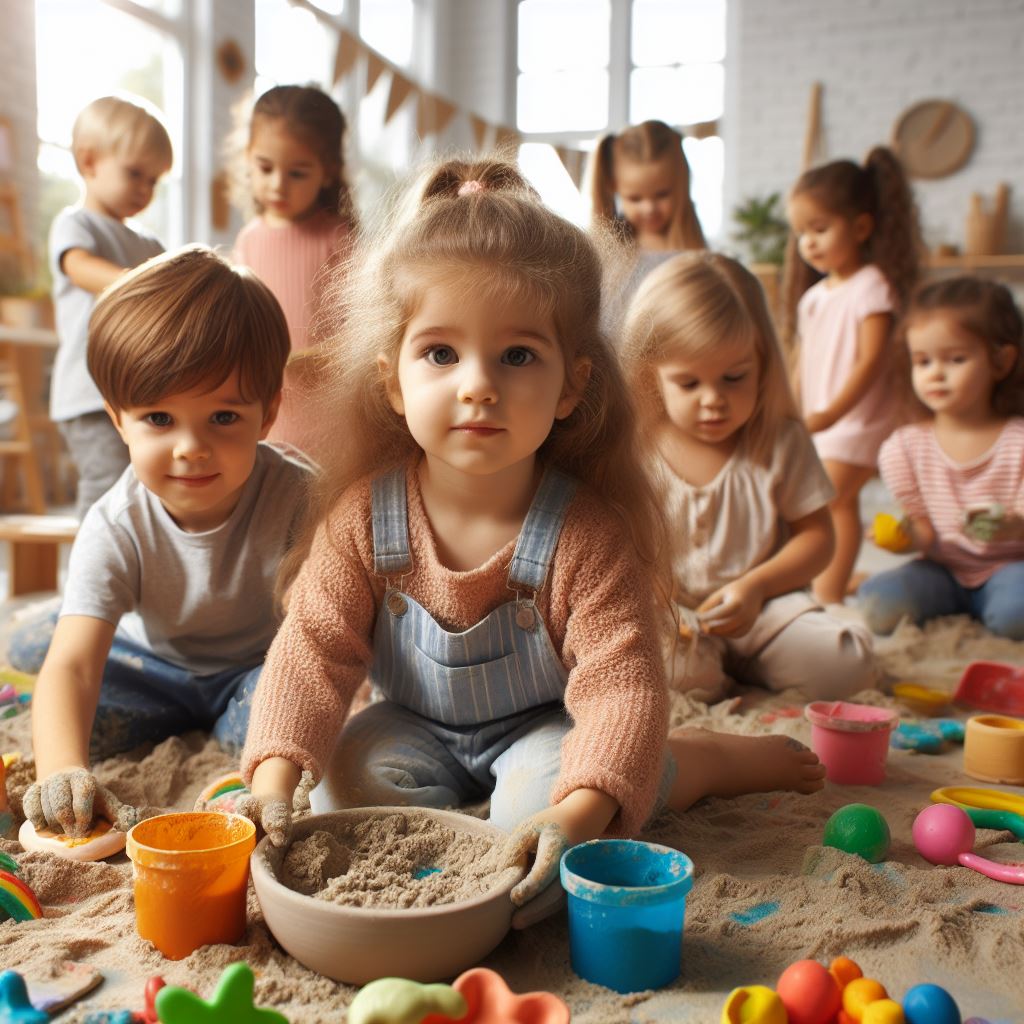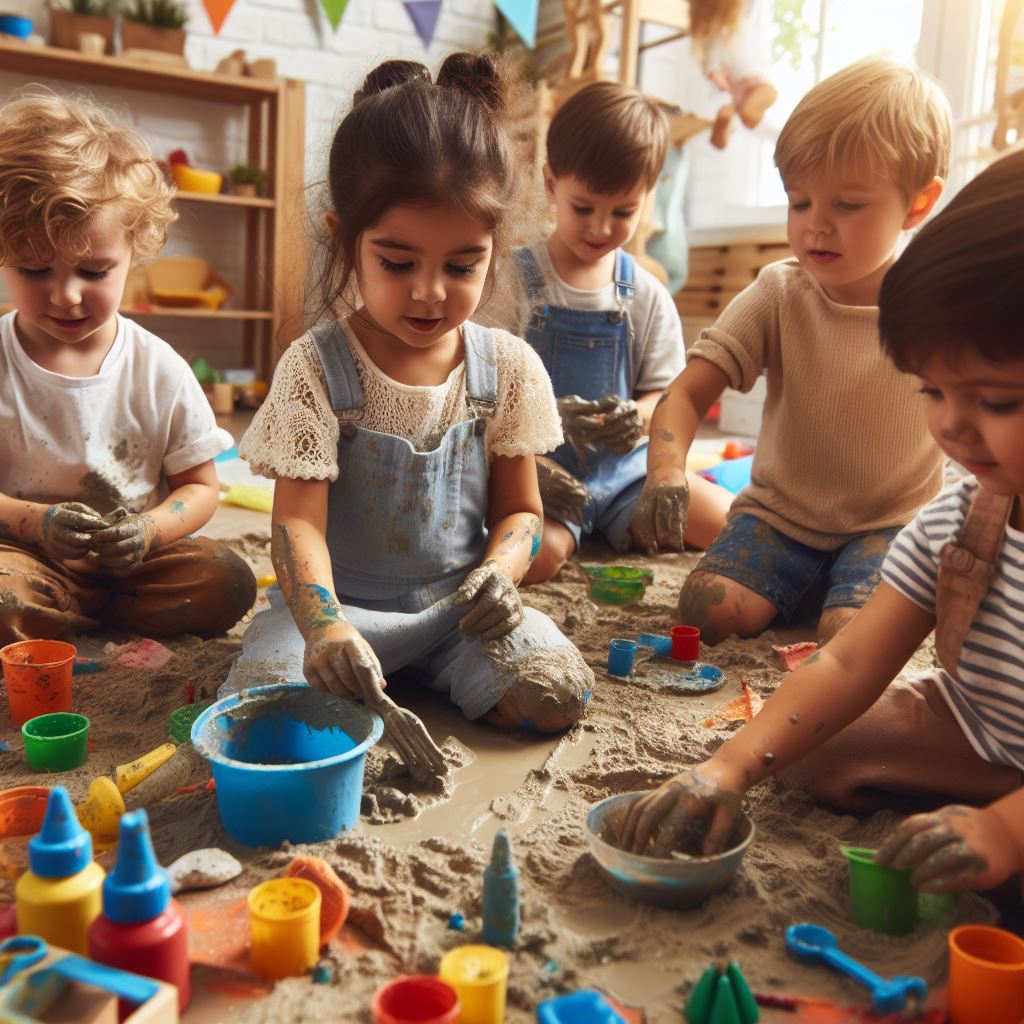
Ah, mess: the bane of pristine homes and the joy of childhood whimsy! As a 30-year-old parent standing amidst an explosion of toys, art materials, or the day’s breakfast still sticking artfully to the walls, you might be fighting the instinct to clean up the chaos.
Messy play might stir a sense of dread for those who love order and tidiness, but it is a veritable King Midas touch when it comes to child sensory development activities. It is through this seemingly unruly form of play that children explore, learn, and ignite a spark of creativity that neatly stacked toys can rarely offer. So, grab your play apron, and let’s navigate the exuberant terrain of messy play together!
Messy Play Benefits
When we talk about messy play, we invoke every activity that lets children squish, splash, sift, and pour. This tactile exploration is crucial because it engages multiple senses simultaneously, providing a wealth of neurological benefits. Through touch, sight, and often taste, messy play fosters cognitive growth, enhances fine motor skills, and improves hand-eye coordination. Plus, it’s leaps and bounds ahead in promoting imaginative thinking and problem-solving abilities.
By being slap-bang in the middle of a mess, children learn concepts such as cause and effect, volume, and texture, which are abstract ideas made concrete through their gooey and squishy adventures. Additionally, the open-ended nature of messy play means kids are the masters of their creations, learning autonomy and decision-making. And let’s not forget the emotional regulation skills honed when dealing with the ups and downs of a messy endeavor.
Safe Messy Play Ideas: Encouraging Exploration Without the Stress
Safety is paramount, and while messy play champions the unpredictable, we don’t want that extending into health or well-being. Here’s how you can create safe environments for your child to get messy:
– Use baby-safe, non-toxic materials and natural ingredients whenever possible; think water, sand, and food-grade colors.
– Set up a designated messy zone. This can easily be a plastic sheet or a splash mat laid out in an area that’s easy to clean – a corner of the kitchen, the garage, or the backyard.
– Have a clean-up plan. Keep towels, wipes, and a change of clothes at hand to manage the aftermath efficiently.
Parent-Child Bonding Through Play
The beauty of messy play isn’t just in the mess—it’s in the memories you create. As a parent, joining in on the chaos can foster a deep connection with your little one. It shows them that you value their interests and are willing to step into their world. This shared experience can strengthen your bond, making for a cherished memory in your child’s album of life.
Be their playmate, be their audience, or be their conspirator in the grand messy game. As you laugh and create together, you’re building trust, understanding, and affection.
Creative Indoor Play Activities
When the skies turn gray, fear not—your messy play doesn’t have to be put on hold. Here are some inventive ways to bring the fun indoors:
1. Edible Finger Paints: Mix some food coloring with a base of Greek yogurt or sugar-free pudding for a delicious art session. Spread large sheets of paper on the floor or fix them on the walls for vertical painting and let the mini Picassos get to work. With edible paints, you won’t have to worry about them putting their fingers in their mouths.
2. Homemade Play Dough: Combine flour, salt, cream of tartar, water, vegetable oil, and food coloring to make a non-toxic, moldable dough. This dough can be anything—a pretend meal, a work of art, or a novel creature from your child’s imagination.
3. Sensory Bins: Fill a large container with dry rice, beans, or pasta. Embed various toys and objects for your child to discover. This treasure hunt can be a fascinating experience that stimulates their sense of touch and proprioception.
4. Bubble Wrap Runway: Lay out a long strip of bubble wrap and let your kids crawl, jump, and stomp their way through. The noise, the texture, and the visual pop are a trifecta of sensory delight.
5. DIY Obstacle Course: Use pillows, cardboard boxes, and blankets to create an indoor obstacle course. Crawling, climbing, and squeezing through the various barriers is not just physically engaging but mentally stimulating as well.
Each of these activities is a chance for your child to explore, learn, and grow. They are simple, inexpensive, and infinitely adaptable to whatever resources you have at hand.
Mess as a Catalyst for Growth

As you embrace the disorder and give your child the freedom to revel in splatters and spills, remember that you are facilitating a pivotal aspect of their growth. Messy play presents a canvas for your children to express themselves without the constraints of ‘right’ and ‘wrong.’
If you find it particularly hard to let go of tidiness, here’s a perspective that might help: every splash of paint, every cookie crumb that finds its way under the table, or every grain of sand that escapes the bin, is a stepping stone in your child’s journey to becoming a rounded, inquisitive, and creative individual.
Setting the stage for this type of play may seem daunting, but the benefits for your child’s sensory and emotional development cannot be overstated. The warmth of parent-child bonding through play, the canvas for creative indoor activities, and the myriad opportunities for learning are all hidden within those untidy moments. Indeed, the heart of early child development beats vibrantly amid the joyful clamor of messy play.
Set your “mess apprehensions” aside and seize this unique and formative period in your child’s life. Embrace the controlled chaos, for therein lies the path to a rich and rewarding developmental adventure with your child—one splatter, squish, and giggle at a time.

